State Appointed Jesters
Royal families were not the only ones who employed jesters to entertain. From noble families in Europe, to kingdoms across the sea, jesters made their home wherever they could bring laughter and comedy.
Noblemen in Medieval Europe
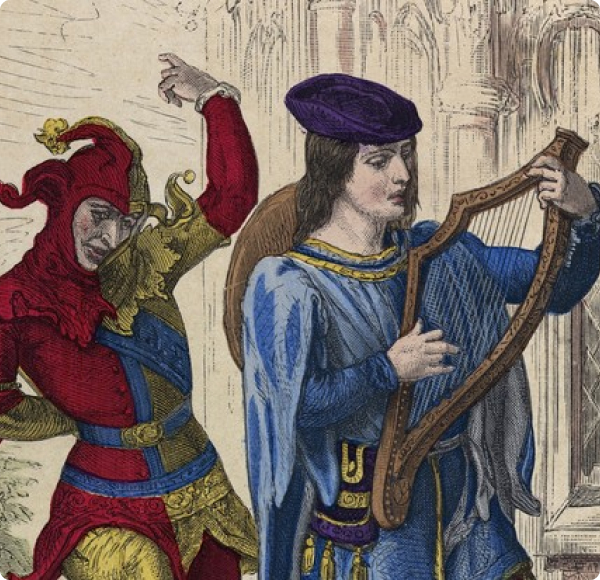
Medieval Court Jester | History Extra
The ownership and role of jesters differed between noblemen who owned jesters and those who served as royal court jesters. While both positions involved entertaining and amusing their patrons, there were distinct differences in their social status, responsibilities, and the nature of their performances.
Noblemen who owned jesters held them as personal entertainers and companions within their households. These jesters were typically employed by wealthy aristocrats and landowners. Unlike royal court jesters, they were not directly connected to the monarch or the central administration of the kingdom. As such, their social status varied depending on the favour and wealth of their individual noble patrons1.
Noble-owned jesters often had a more intimate relationship with their owners and their families. They were expected to provide constant entertainment and amusement within the household, using their comedic talents to bring laughter and joy to their noble patrons. These jesters were known to perform at private gatherings, banquets, and events hosted by their noble owners. They would tailor their performances to suit the preferences and tastes of their specific patrons, often incorporating personal anecdotes and inside jokes.
In contrast, royal court jesters were members of the monarch’s court and held a more prestigious position. They were part of the official entourage and were directly associated with the ruling monarch and the royal court. Royal court jesters were often chosen based on their exceptional comedic abilities, intelligence, and wit. Their performances were not only intended to entertain but also to provide social and political commentary, as well as serve as trusted confidants to the monarch.
Chinese Jesters
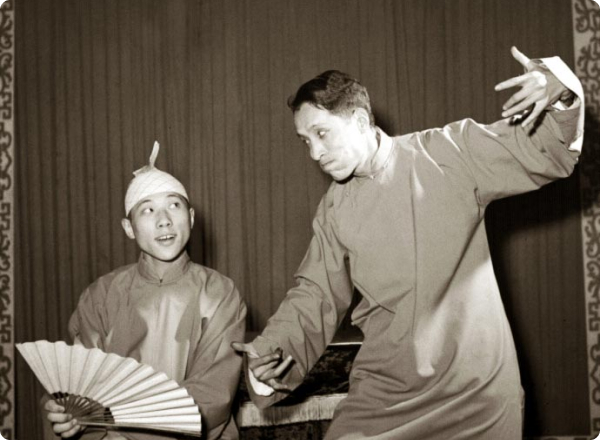
Xiangsheng | People’s Daily
When it comes to jesters, China and Europe have their own unique styles and traditions. Chinese jesters, known as “xiangsheng” (translating to cross-talk) were distinct from their European counterparts in several fascinating ways.
Chinese jesters had a rich history that predates their European counterparts by centuries. The tradition of xiangsheng can be traced back to the Qin Dynasty (221-206 BCE), making it one of the oldest forms of comedic performance in the world. In contrast, court jesters in Europe didn’t become prevalent until the mediaeval period.
One significant difference between Chinese xiangsheng and European court jesters was the nature of their performances. While European jesters often entertained through physical comedy, acrobatics, and slapstick humour, Chinese jesters focused more on verbal wit and wordplay. Xiangsheng performances typically involved a duo engaging in rapid-fire banter, using puns, rhymes, and clever language to entertain the audience. This linguistic artistry showcased the importance of wit and intellectual humour in Chinese culture.
The social status of jesters in China differed from that of their European counterparts. In Europe, court jesters were usually employed by nobility and held a low social status, often being considered fools. In contrast, Chinese xiangsheng performers were highly respected and held in high regard. They were often considered intellectuals and were valued for their ability to entertain while conveying social commentary and satire. Xiangsheng performers were even sought after as guests at banquets and important events.
Chinese jesters were deeply rooted in Chinese culture and traditions. Their performances often incorporated elements of traditional Chinese opera, storytelling, and historical references. By contrast, European court jesters had more freedom to incorporate elements from different cultures and regions2.
While court jesters in Europe primarily entertained within royal courts, Chinese jesters had a broader reach. Xiangsheng performances were popular among common people and could be enjoyed in teahouses, theatres, and even on the streets. This accessibility allowed xiangsheng to become an integral part of Chinese popular culture, enjoyed by people from all walks of life.
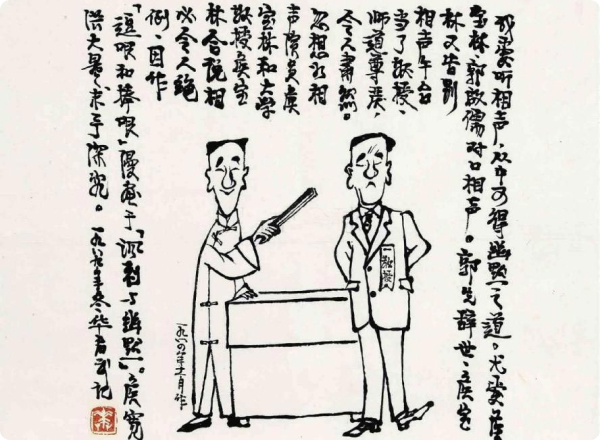
Xiangsheng | People’s Daily
Japanese Jesters
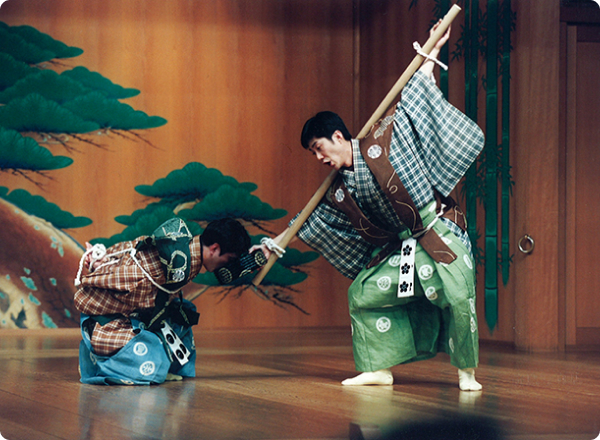
Kyogen Stage Performance | UCLA
In Japan, traditional theatre forms such as Kabuki and Noh incorporated comedic elements through the inclusion of kyogen performances. Kyogen, which means “crazy words” or “wild speech,” emerged as a distinct comedic genre in the 14th century and played an important role in balancing the seriousness and intensity of the main acts in these theatrical traditions3. These performers were skilled comic actors who specialised in providing comic relief during the intervals of the more serious and stylized Noh or Kabuki performances.
Kyogen relied on physical humour, exaggerated gestures, and comedic timing to elicit laughter from the audience. The performers employed a range of comedic techniques, including slapstick, wordplay, puns, misunderstandings, and humorous dialogues. They used comedic masks, distinctive costumes, and stylized movements to bring their characters to life.
The comedic interactions in kyogen plays were often characterised by misunderstandings, absurd situations, and comedic reversals. The performers would skillfully navigate these situations, often engaging in clever wordplay and linguistic humour to enhance the comedic effect. The use of exaggerated facial expressions, body language, and vocal intonations added to the comedic impact.
Kyogen plays were not only intended to entertain but also to offer social commentary and satire. They often highlighted human foibles, societal conventions, and the inherent comedic aspects of everyday life. Through their performances, kyogen actors provided a light-hearted perspective on serious themes and added a touch of humour to the otherwise dramatic or spiritual narratives of Noh or Kabuki.
The tradition of kyogen continues to thrive in Japan, with dedicated kyogen troupes and performers preserving and innovating the art form. While the original kyogen plays were often performed in traditional theatre settings, contemporary kyogen performances can be seen in various venues, including festivals, cultural events, and even modern theatre productions4.
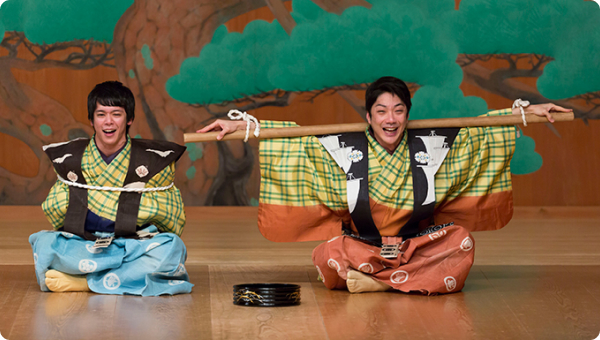
Kyogen Stage Performance | UCLA
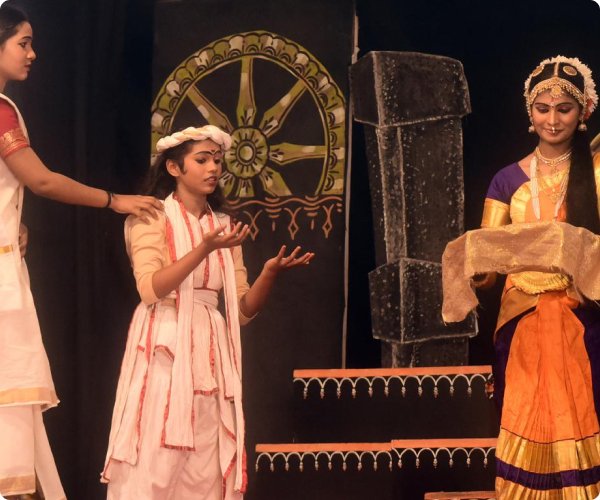
Vidushakas Stage Performance | The Hindu
India indeed has a rich tradition of comedic entertainment that dates back centuries. In ancient times, during the era of Sanskrit dramas, jesters and clowns known as “vidushakas” played a significant role in theatrical productions5. These skilled performers brought levity to the serious themes and complex narratives of Sanskrit plays.
The vidushakas were known for their wit, physical comedy, and wordplay. They would use their comedic timing, exaggerated gestures, and humorous dialogues to elicit laughter from the audience. Often, their characters served as comedic foils to the main protagonists, providing comic relief and adding an element of light-heartedness to the performances. Vidushakas were adept at playing multiple roles and were known for their improvisational skills, making their performances lively and engaging6.
As centuries passed, the tradition of comedic entertainment in India continued to evolve. In the modern era, Indian cinema and television have played a crucial role in popularising comedy and bringing it to a wider audience. Indian films, especially in the Hindi film industry (Bollywood), frequently feature comedic actors who specialise in various comedic genres, such as slapstick comedy, satire, situational comedy, and witty wordplay.
Persian jesters were known as “masḵara” or “dalqak”. Often the word dalqak is used to refer to their royal court jesters and fools whose main role was entertaining the court7.
Persian masḵara performed in a more intimate setting, often in the presence of the ruler or a select group of dignitaries8. They used a more subtle and refined style of humour, employing clever wordplay and intellectual banter to entertain the court.
The jesters of mediaeval Europe were part of a Christian cultural framework, often drawing from Christian traditions and themes in their performances. In contrast, Persian mascara were deeply rooted in Persian culture and history, incorporating elements of poetry, music, and storytelling that were intrinsic to the Persian artistic tradition. Their performances often showcased the rich literary and cultural heritage of Persia.
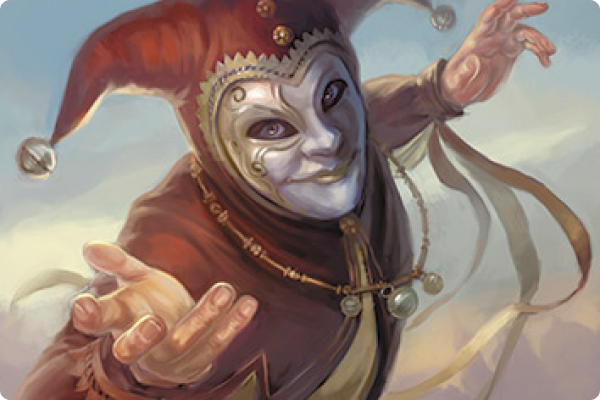
Jester | Dominion
Resources:
- Franco, S. (2023, February 3). A medieval jester had to laugh in the face of danger. Thevintagenews. https://www.thevintagenews.com/2023/02/03/medieval-jester/
- Cristil. (2020, February 29). Fools Are Everywhere: The Court Jester around the World | History Cooperative. History Cooperative. https://historycooperative.org/journal/fools-are-everywhere-the-court-jester-around-the-world/
- the-noh.com : Introducing the world of Noh : What is Kyogen? (n.d.). https://www.the-noh.com/en/world/kyogen.html
- 能楽協会公. (n.d.). Introduction to Kyōgen. https://www.nohgaku.or.jp/en/guide/kyogen
- www.wisdomlib.org. (2025, February 17). Vidushaka: Significance and symbolism. https://www.wisdomlib.org/concept/vidushaka
- Vidushaka | clown | Britannica. (n.d.). Encyclopedia Britannica. https://www.britannica.com/art/vidushaka
- Encyclopaedia Iranica Foundation. (n.d.). Welcome to Encyclopaedia Iranica. https://www.iranicaonline.org/articles/dalqak-buffoon-court-jester-also-sometimes-known-as-maskara
- Beatriceotto, & Beatriceotto. (2023, August 24). Dalqak – Persian – www.foolsareeverywhere.com. www.foolsareeverywhere.com. https://www.foolsareeverywhere.com/lexicon-persian-dalqak/

